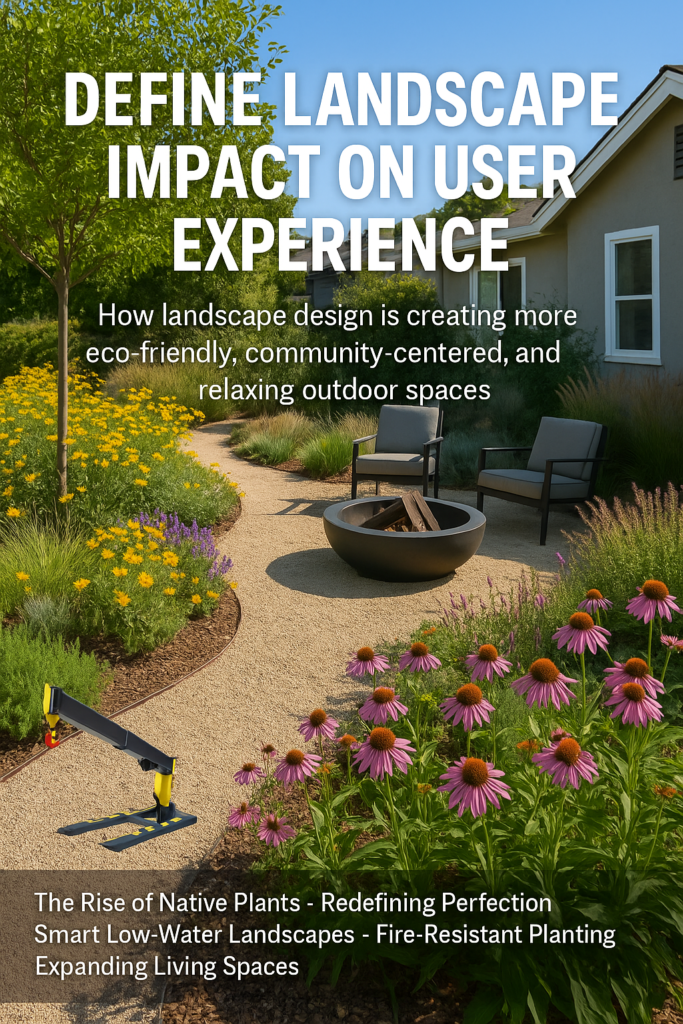The way we define landscape in modern outdoor spaces has shifted dramatically over the past decade. In 2025, landscape design is no longer about aesthetics alone; it is about creating user experiences that foster sustainability, well-being, and community connection. From eco-friendly developments to urban smart cities, landscapes are being reimagined as essential spaces that affect how people live, interact, and thrive.
This article explores the impact of defining landscapes on user experience, blending trends in sustainable design, resilient planting, and advanced technology with human-centered design principles.
Understanding the User Experience in Landscape Design
User experience (UX) in outdoor design focuses on how people feel and interact with their environment. Just as a well-designed website ensures ease of navigation, a well-planned garden or outdoor space ensures comfort, engagement, and accessibility.
When we define landscape for UX, we consider:
- Functionality: Does the space support recreation, relaxation, or urban resilience?
- Accessibility: Are pathways clear, shaded, and usable for all?
- Emotional Response: Does the space evoke calm, joy, or inspiration?
- Sustainability: Does it meet ecological goals while supporting human needs?
These layers of design elevate landscapes beyond “decoration” and instead transform them into vital human-centered environments.
Landscape Trends That Shape User Experiences in 2025
The 2025 garden design trends highlight how landscape choices impact both individual and collective experiences.
1. The Rise of Native Plants and Nativars
Native plants and their cultivated counterparts—nativars—are reshaping gardens. Their ecological benefits include habitat creation for pollinators, resilience to local conditions, and reduced maintenance. For users, they create authentic, immersive experiences tied to regional identity.
2. Redefining Perfection
A less “manicured” aesthetic encourages natural cycles of growth, decay, and renewal. By redefining perfection, users are encouraged to accept and enjoy the organic beauty of change, which fosters mindfulness and mental well-being.
3. Smart Low-Water Landscapes
Designers now recognize that lush, flower-filled gardens can exist with water-wise plantings. For residents in drought-prone regions, this trend balances beauty with environmental responsibility—ensuring people can enjoy abundant color without guilt or excess resource use.
4. Fire-Resistant Planting
Safety-focused planting improves user confidence in fire-prone areas. Choosing fire-adaptive species like sago palms or succulents not only preserves property but provides peace of mind.
5. Expanding Living Spaces for People and Wildlife
Pollinator-friendly gardens, rooftop greenspaces, and repurposed strips provide multi-user benefits: humans enjoy recreation while birds, bees, and butterflies gain critical habitat.
Defining Landscape for Eco-Friendly Projects
One of the most profound impacts of landscape design on user experience lies in eco-friendly projects. Green developments prioritize native species, stormwater management, and renewable energy integration to create spaces that are sustainable and restorative.
Read more here: Define Landscape Focus in Eco-Friendly Projects
In such spaces, users experience improved air quality, cooler temperatures, and greater biodiversity—all of which enhance well-being and daily life.
Smart Cities: Technology Meets Green Design
Urban density creates challenges for outdoor space, but smart cities are leveraging technology to define landscape in innovative ways. Automated irrigation, green roofs, and vertical gardens contribute to resilient cities that prioritize user comfort.
Discover more: Define Landscape Solutions in Smart Cities
For users, this means more shaded walkways, greener rooftops, and calming pocket gardens embedded in the urban fabric. These designs soften the hard edges of modern cities while reducing heat-island effects.
Harmony in Outdoor Design: Blending Aesthetics and Functionality
Landscape harmony is about crafting a balance between architecture, nature, and human needs. Outdoor design that is both functional and beautiful leads to intuitive spaces that feel welcoming and purposeful.
Learn more: Define Landscape Harmony in Outdoor Design
For users, harmonious landscapes provide clarity—spaces are naturally navigable, comfortable, and emotionally uplifting. Whether walking along shaded paths or enjoying a firepit corner, these landscapes enrich human experiences.
Tools and Equipment: Behind the Scenes of User Experience
The user experience of landscapes depends heavily on the craftsmanship behind them. Reliable tools and lifting solutions help builders and landscapers safely position materials like stone, glass, and concrete that shape outdoor spaces.
For instance, the forklift boom allows crews to maneuver heavy components with precision, ensuring efficiency and safety on-site. By enabling faster installations and reduced labor risks, such tools indirectly enhance the final user experience of the landscape.
Emotional and Social Benefits of Thoughtful Landscapes
The impact of how we define landscape is not purely physical. Landscapes contribute to:
- Mental Health: Quiet gardens reduce stress and provide restorative environments.
- Social Connections: Outdoor rooms and communal gardens bring people together.
- Identity and Pride: Landscapes reflect cultural values and heritage, fostering belonging.
- Environmental Awareness: Eco-conscious gardens teach users about sustainability.
Integrating Technology for User Comfort
Smart lighting, retractable awnings, and automated water systems are redefining how people use outdoor spaces. These technologies improve usability, extending garden enjoyment into evenings or across seasons.
Pairing these innovations with sustainable building solutions, such as Insulating Glass Unit Selection Tips for Architects, ensures energy efficiency and visual comfort in connected indoor-outdoor designs.
Conclusion: The Future of User-Centered Landscapes
In 2025, to define landscape is to define experience. From eco-friendly gardens to smart city innovations, landscapes now integrate sustainability, safety, and user needs into every decision. Tools like forklift booms ensure projects are executed safely, while design philosophies centered on harmony and resilience ensure the results are meaningful.
As trends evolve, one thing remains clear: landscapes profoundly shape how people live, connect, and thrive. By focusing on user experience, designers are not only beautifying outdoor spaces but also crafting environments that restore, inspire, and endure.

